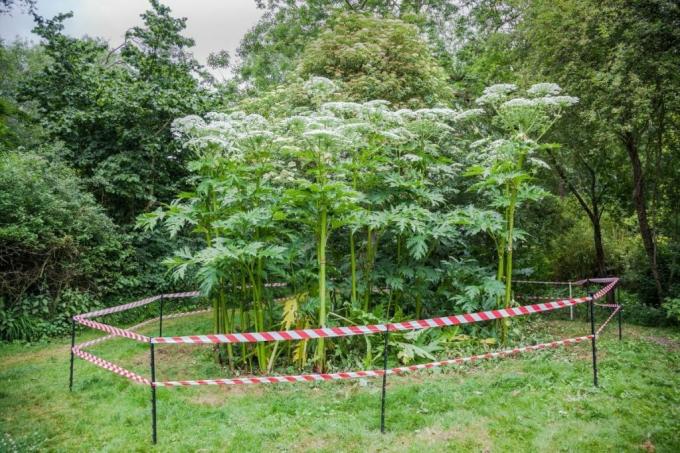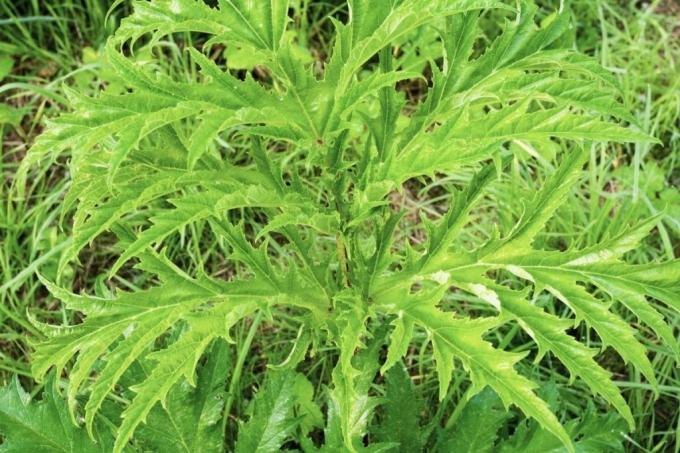
table of contents
- Recognize giant hogweed
- Necessary fight
- measures
- Separate the plant
- Herbicides
- Remove seed heads
- Unsuitable measures
- Giant hogweed freely growing
- frequently asked Questions
Giant hogweed in the garden is particularly dangerous for children and pets. Because of this, it must be eliminated. How to fight giant hogweed and what to watch out for is in this article.
In a nutshell
- Giant hogweed is a poisonous, invasive plant
- fighting it is not easy
- protective clothing is mandatory
- only digging out the roots helps in the long term
- Herbicides are not permitted for private use
Recognize giant hogweed
- botanical: Heracleum mantegazzianum
- Synonym: Hercules shrub
- originally from the Caucasus
- biennial
- Plant takes on imposing growths
- grows on rubble sites, on the edges of forests, in gardens
- upright growth, large prickly leaves
- forms umbellate flowers with innumerable seeds

Necessary fight
The giant hogweed is an invasive species that displaces native plants. The plant is also poisonous and even touching the shrub can lead to skin irritation. The reason for this are ingredients that react with sunlight and cause burns. The process of skin damage is as follows:
- The plant is touched. Usually this does not lead to problems, except for very sensitive people or sensitive skin areas.
- The person comes into contact with UV radiation. The earlier the affected skin areas come into contact with sunlight, the more dangerous it is. However, the sun can still cause damage days later.
- Symptoms then appear around a day after exposure to the sun's rays. These include redness, burns, blistering.
- The wounds heal badly. More UV radiation can make it worse.
- If sap comes on the skin, wash it off extensively and do not expose it to the sun for at least three days. Consult a doctor in the event of burning, itching, or redness.
measures
The most important prerequisite for fighting giant hogweed is the right clothing. This includes not only long-sleeved clothing made of sturdy material, but also protective goggles and thick gloves.
The right time for the action is also important. The sun shouldn't be shining. An overcast, rainy day is best. Or work is done in the evening when the sun has set.
Separate the plant
- apart from the protective clothing, sharp tools are required
- spades or knives are suitable
- best time in spring
- The plant is then still young and small
- deep cutting is important
- to do this, partially expose plant shoots and roots
- Avoid damaging the plant itself
- Cut the roots at least 15 cm deep, or even deeper
- Dispose of the separated root piece in the household waste
- It is best to leave the hole in the ground open
- remove new shoots as well
- it may take a while for the plant to be completely destroyed

Herbicides
- Protective clothing is also important when using herbicides
- only to be carried out or to have carried out with proof of competence
- best time for half-height plants with not too much leaf mass
- Use herbicide only for this purpose
- avoid damaging other plants
- Means that are absorbed through the leaves work best
- Treat the planter exactly as directed by the product
- part of the root may survive
- new shoots must then be treated again
Remove seed heads
- for this control, the plant must first grow and bloom
- Wear protective clothing, use knives or other sharp cutting tools
- The best time is when the main flowers have faded, but the seeds are not yet mature
- secure the cones with a plastic bag
- this prevents seeds from falling out
- Cut off the cones, not forgetting the auxiliary cones
- collect all cut off plant parts and throw them in the trash
- Let the rest of the plant stand, it will wither by itself

Unsuitable measures
- Devices that increase the risk of the sap being widely distributed
- everything that ensures that the seeds can spread
- thermal treatments before flowering, the root sprouts again
- superficial hooking or mowing
Giant hogweed freely growing
In order to combat giant hogweed plants growing in the wild, the local public order office is responsible or, if available, specially set up reporting points. These then regulate the removal of the plants on site.
frequently asked Questions
Adult plants cannot be confused because of their size. The situation is different with young plants that can be confused with native species, such as the meadow hogweed. This has a stem that has no reddish spots.
In fact, some sheep and goats eat the plant, but only inevitably. It doesn't harm them. Permanent grazing can be very effective against plant populations.
In fact, the countless flowers are a good pasture for bees. Since the mother plant dies after flowering anyway, it makes sense to limit the spread only before the seeds ripen.
